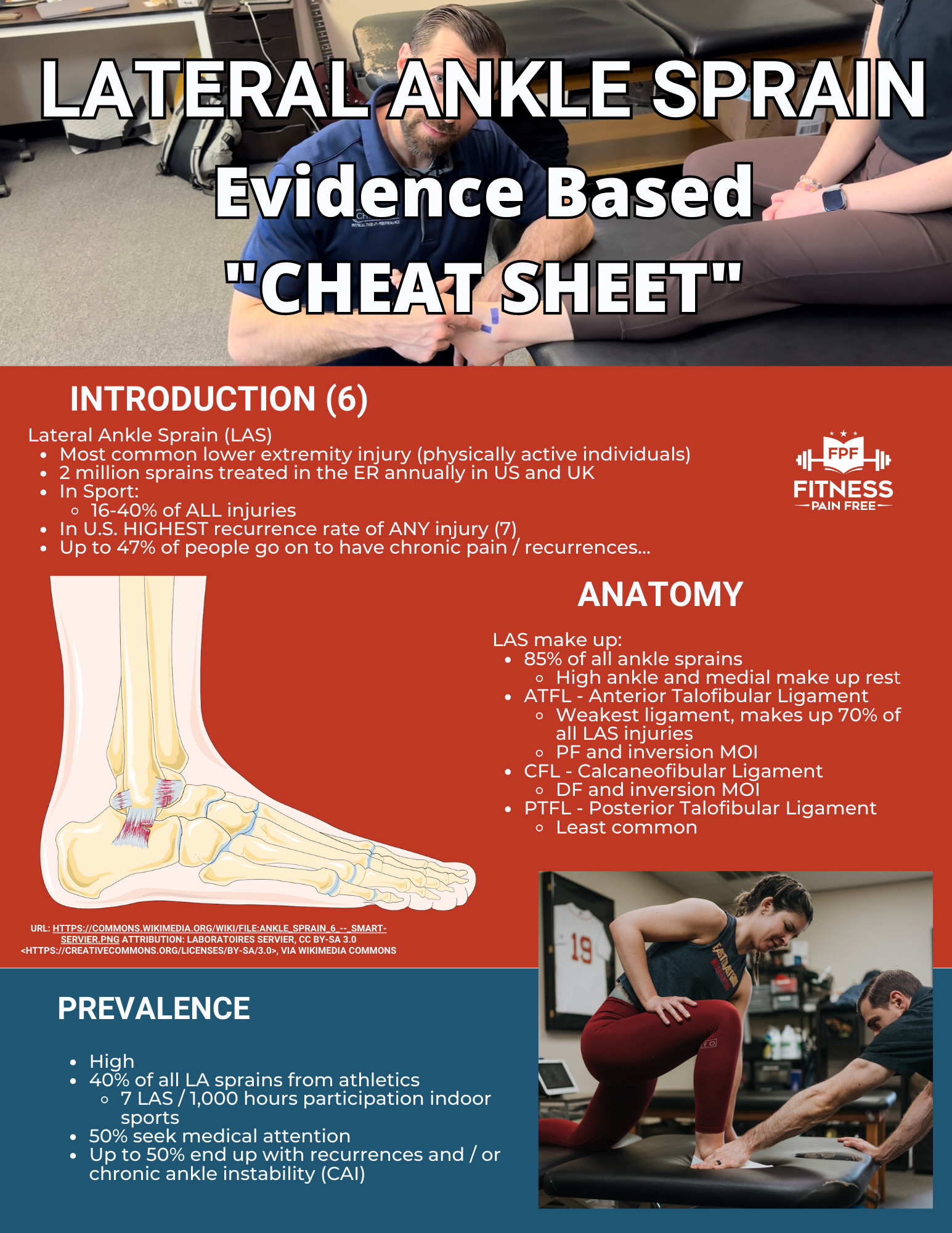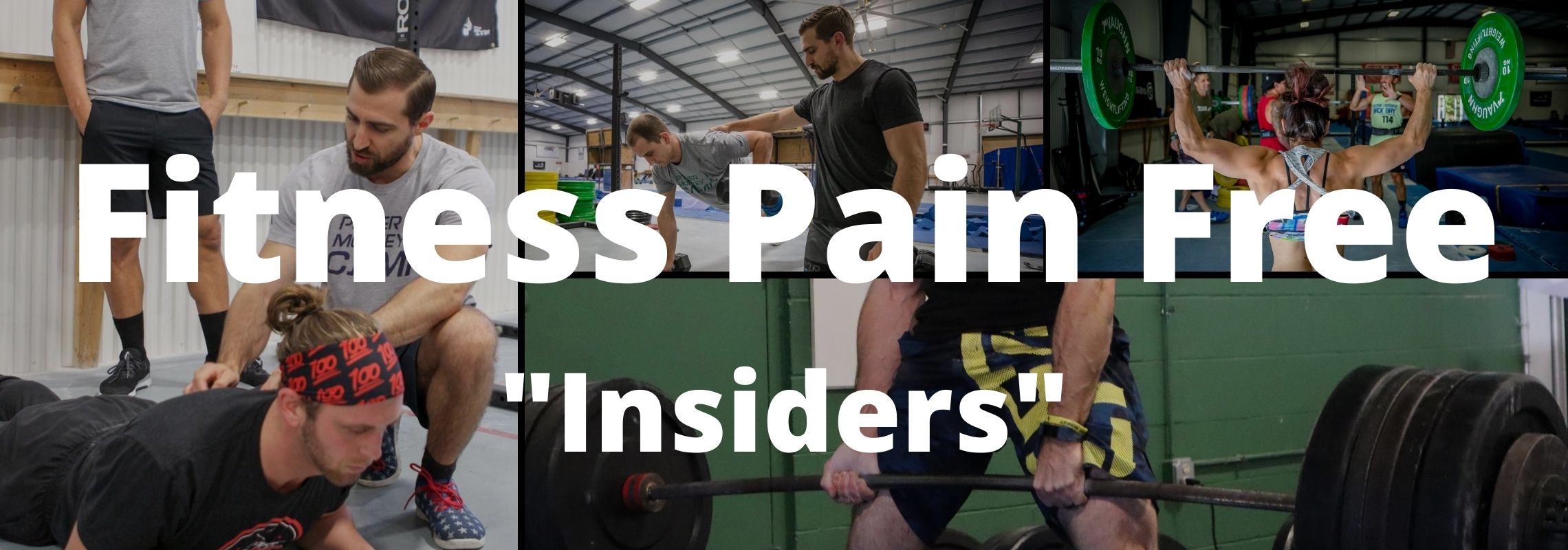
Evidence Based Guide to Lateral Ankle Sprains for Physical Therapists | Prevalence, Clinical Presentation and Risk Factors | FPF Show Episode 85
To go along with today's episode I have a nice infographic to share...
Evidence Based Lateral Ankle Sprain "Cheat Sheet" for Clinicians
Click HERE to download it for FREE:
Click HERE to Download FREE
Grab the rest of the Mini Course and Sign up for the Certification Pre-sale list:
- FPF Mini Course - 7 Reasons Why Injuries Happen in the Gym and What to do About it
- The Fitness Pain Free Certification
In today's episode we go over an Evidence Based Guide to Lateral Ankle Sprains for Physical Therapists | Prevalence, Clinical Presentation and Risk Factors | FPF Show Episode 85:
Welcome, physical therapists, to this evidence-based guide on managing ankle sprains. Ankle sprains are among the most common lower extremity injuries encountered in clinical practice (and especially in sports). As experts in rehabilitation, it is crucial for us to stay up-to-date with the latest research to provide the best care to our patients. This guide aims to provide you with evidence-based strategies and interventions to optimize the rehabilitation process for ankle sprains.
- Initial Assessment and Diagnosis: A comprehensive assessment is essential to determine the severity and nature of the ankle sprain. Key components of the assessment include patient history, mechanism of injury, physical examination, and imaging (if necessary). The Ottawa Ankle Rules can be a useful tool to determine the need for imaging in acute ankle injuries.
- Management of Acute Phase: The RICE (Rest, Ice, Compression, Elevation) principle has traditionally been recommended for the acute management of ankle sprains. It's the best... NOT! More recent evidence suggests that early mobilization and weight-bearing may lead to better outcomes.
- Strength and Proprioception Training:Weakness and impaired proprioception are common after ankle sprains, contributing to a higher risk of reinjury. Incorporate exercises that target ankle dorsiflexion, plantarflexion, inversion, and eversion, with a specific focus on exercise specificity to help your patient return to their sport or activity of choice. Proprioceptive training, such as balance exercises on unstable surfaces, can improve ankle stability and reduce the risk of recurrent sprains.
- Neuromuscular Control and Agility Training: After regaining strength and stability, progress to neuromuscular control and agility training. This includes activities that challenge dynamic balance, multidirectional movements, cutting, jumping, and landing. Emphasize proper movement mechanics and encourage reactive responses to simulate real-life situationss or sporting activities.
- Manual Therapy Techniques: Consider using manual therapy techniques as adjuncts to exercise-based interventions. Joint mobilizations, soft tissue mobilizations, and proprioceptive taping techniques may help reduce pain, improve range of motion, and enhance motor control. However, their effectiveness as standalone treatments remains limited.
- Return to Sport Criteria: To ensure a safe return to sport or physical activity, utilize evidence-based criteria rather than relying solely on the passage of time. The criteria should include functional assessments, such as single-leg hop tests, balance tests, and sport-specific tasks. Ensure that the athlete demonstrates symmetry, proper neuromuscular control, and the ability to perform sport-specific movements without pain or compensation.
- Psychological Considerations: Acknowledge the psychological impact of ankle sprains on athletes and patients. Address their fears, concerns, and expectations during the rehabilitation process. Incorporate strategies such as goal setting, education, and motivational interviewing to enhance patient adherence and mental well-being.
- Prevention Strategies: Educate patients on the importance of continuing exercises and functional supports (like lace up brace) to help prevent future ankle sprains. Consider implementing injury prevention programs that focus on balance, agility, and sport-specific movements.
In today's video we go over part 1 of our evidence based guide to lateral ankle sprains:
By incorporating evidence-based interventions, physical therapists can optimize the management of ankle sprains and facilitate a safe return to sport or daily activities. Individualize treatment plans based on patient characteristics and address both physical and psychological aspects throughout the rehabilitation process. By staying informed and implementing best practices, we can enhance patient outcomes and reduce the risk of recurrent ankle sprains.
Cankles no more...
- Dan Pope DPT,OCS,CSCS
Show Notes / Relevant Articles:
Want to support me and decide topics for future episodes? Click HERE to sign up for FPF "Insiders" for just a dollar. You'll gain access to 100+ webinars, e-books and complete guides. Plus, you'll get private access to the "Insiders" Facebook group where you can have all of your questions answered by me.
Looking for other ways to support me that are 100% free?
- Like, comment and share on youtube, facebook and instagram
- Leave a 5-star review on apple podcasts
Thank you!
Dan Pope DPT, OCS, CSCS
References:
Vuurberg G, Hoorntje A, Wink LM, et al. Br J Sports Med 2018
van Middelkoop M, van Rijn RM, Verhaar JA, Koes BW, Bierma-Zeinstra SM. Re-sprains during the first 3 months after initial ankle sprain are related to incomplete recovery: an observational study. J Physiother. 2012;58(3):181-8. doi: 10.1016/S1836-9553(12)70109-1. PMID: 22884185.
Kemler E, Thijs KM, Badenbroek I, van de Port IG, Hoes AW, Backx FJ. Long-term prognosis of acute lateral ankle ligamentous sprains: high incidence of recurrences and residual symptoms. Fam Pract. 2016 Dec;33(6):596-600. doi: 10.1093/fampra/cmw076. Epub 2016 Aug 17. PMID: 27535328.
Bendahou M, Khiami F, Saïdi K, Blanchard C, Scepi M, Riou B, Besch S, Hausfater P. Compression stockings in ankle sprain: a multicenter randomized study. Am J Emerg Med. 2014 Sep;32(9):1005-10. doi: 10.1016/j.ajem.2014.05.054. Epub 2014 Jun 12. PMID: 25043629.
Link: https://www.jospt.org/doi/10.2519/jospt.2013.4792 Cleland JA, Mintken PE, McDevitt A, Bieniek ML, Carpenter KJ, Kulp K, Whitman JM. Manual physical therapy and exercise versus supervised home exercise in the management of patients with inversion ankle sprain: a multicenter randomized clinical trial. J Orthop Sports Phys Ther. 2013;43(7):443-55. doi: 10.2519/jospt.2013.4792. Epub 2013 Apr 29. PMID: 23628755.
Halabchi F, Hassabi M. Acute ankle sprain in athletes: Clinical aspects and algorithmic approach. World J Orthop. 2020 Dec 18;11(12):534-558. doi: 10.5312/wjo.v11.i12.534. PMID: 33362991; PMCID: PMC7745493.
Wagemans J, Bleakley C, Taeymans J, Schurz AP, Kuppens K, Baur H, Vissers D. Exercise-based rehabilitation reduces reinjury following acute lateral ankle sprain: A systematic review update with meta-analysis. PLoS One. 2022 Feb 8;17(2):e0262023. doi: 10.1371/journal.pone.0262023. PMID: 35134061; PMCID: PMC8824326.
Smith MD, Vicenzino B, Bahr R, Bandholm T, Cooke R, Mendonça LM, Fourchet F, Glasgow P, Gribble PA, Herrington L, Hiller CE, Lee SY, Macaluso A, Meeusen R, Owoeye OBA, Reid D, Tassignon B, Terada M, Thorborg K, Verhagen E, Verschueren J, Wang D, Whiteley R, Wikstrom EA, Delahunt E. Return to sport decisions after an acute lateral ankle sprain injury: introducing the PAASS framework-an international multidisciplinary consensus. Br J Sports Med. 2021 Nov;55(22):1270-1276. doi: 10.1136/bjsports-2021-104087. Epub 2021 Jun 22. PMID: 34158354.
Melanson SW, Shuman VL. Acute Ankle Sprain. [Updated 2022 May 29]. In: StatPearls [Internet]. Treasure Island (FL): StatPearls Publishing; 2023 Jan-. Available from: https://www.ncbi.nlm.nih.gov/books/NBK459212/
Longo UG, Loppini M, Romeo G, van Dijk CN, Maffulli N, Denaro V. Bone bruises associated with acute ankle ligament injury: do they need treatment? Knee Surg Sports Traumatol Arthrosc. 2013 Jun;21(6):1261-8. doi: 10.1007/s00167-013-2383-5. Epub 2013 Jan 19. PMID: 23334625.
Roos KG, Kerr ZY, Mauntel TC, Djoko A, Dompier TP, Wikstrom EA. The Epidemiology of Lateral Ligament Complex Ankle Sprains in National Collegiate Athletic Association Sports. Am J Sports Med. 2017 Jan;45(1):201-209. doi: 10.1177/0363546516660980. Epub 2016 Oct 1. PMID: 27573356.
Ankle Sprain Image:
URL: https://commons.wikimedia.org/wiki/File:Ankle_sprain_6_--_Smart-Servier.png
Attribution: Laboratoires Servier, CC BY-SA 3.0 <https://creativecommons.org/licenses/by-sa/3.0>, via Wikimedia Commons
Johannsen, A. 1978. Acta Orthopaedica. Radiological diagnosis of lateral ligament lesion of the ankle: a comparison between talar tilt and anterior drawer sign.
Sman AD, Hiller CE, Rae K, Linklater J, Black DA, Nicholson LL, Burns J, Refshauge KM. Diagnostic accuracy of clinical tests for ankle syndesmosis injury. Br J Sports Med. 2015 Mar;49(5):323-9. doi: 10.1136/bjsports-2013-092787. Epub 2013 Nov 19. PMID: 24255766.
Ankle Sprain Image: URL: https://commons.wikimedia.org/wiki/File:Sprained_foot.jpg Attribution: Boldie, Public domain, via Wikimedia Commons
Leong NL, Kator JL, Clemens TL, James A, Enamoto-Iwamoto M, Jiang J. Tendon and Ligament Healing and Current Approaches to Tendon and Ligament Regeneration. J Orthop Res. 2020 Jan;38(1):7-12. doi: 10.1002/jor.24475. Epub 2019 Sep 30. PMID: 31529731; PMCID: PMC7307866.

